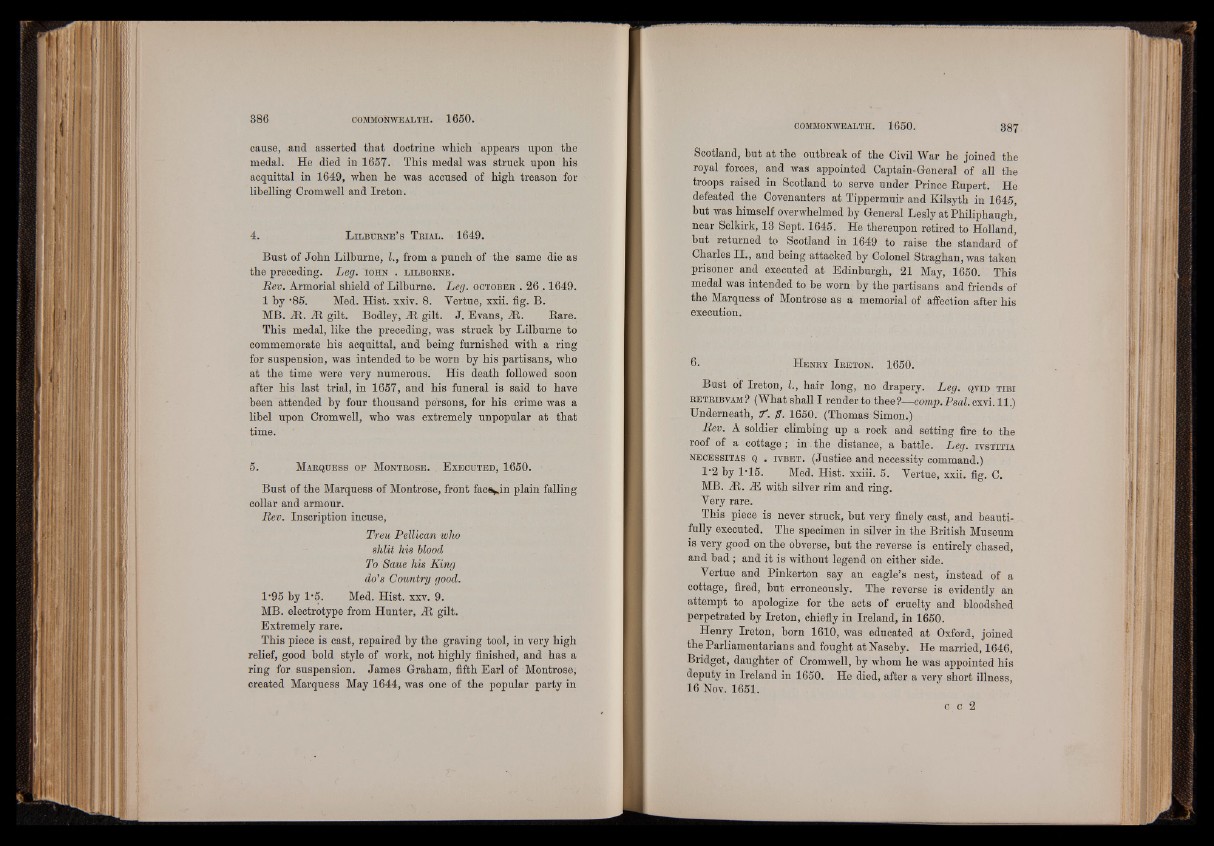
cause, and asserted that doctrine which appears upon the
medal. He died in 1657. This medal was struck upon his
acquittal in 1649, when he was accused of high treason for
libelling Cromwell and Ireton.
4. L il b u e n e ’s T b ia l . 1649.
Bust of John Lilburne, I., from a punch of the same die as
the preceding. Leg. io h n . l il b o b n e .
Rev. Armorial shield of Lilburne. Leg. o c to b eb . 26 .1649.
1 by -85. Med. Hist. xxiv. 8. Vertue, xxii. fig. B.
MB. At. At gilt. Bodley, At gilt. J. Evans, At. Bare.
This medal, like the preceding, was struck by Lilburne to
commemorate his acquittal, and being furnished with a ring
for suspension, was intended to be worn by his partisans, who
at the time were very numerous. His death followed soon
after his last trial, in 1657, and his funeral is said to have
been attended by four thousand persons, for his crime was a
libel upon Cromwell, who was extremely unpopular at that
time.
5. M abqtjess o f M o n t e o s e . E x e c u t e d , 1650.
Bust of the Marquess of Montrose, front fac«y.in plain falling
collar and armour.
Rev. Inscription incuse,
Treu Pellican who
shlit his blood
To Saue his King
do’s Country good.
l -95 by 1‘5. Med. Hist. xxv. 9.
MB. electrotype from Hunter, At gilt.
Extremely rare.
This piece is cast, repaired by the graving tool, in very high
relief, good bold style of work, not highly finished, and has a
ring for suspension. James Graham, fifth Earl of Montrose,
created Marquess May 1644, was one of the popular party in
Scotland, but at the outbreak of the Civil War he joined the
royal forces, and was appointed Captain-General of all the
troops raised in Scotland to serve under Prince Bupert. He
defeated the Covenanters at Tippermuir and Kilsyth in 1645,
but was himself overwhelmed by General Lesly at Philiphaugh,
near Selkirk, 13 Sept. 1645. He thereupon retired to Holland,
but returned to Scotland in 1649 to raise the standard of
Charles 111 and being attacked by Colonel Straghan, was taken
prisoner and executed at Edinburgh, 21 May, 1650. This
medal was intended to be worn by the partisans and friends of
the Marquess of Montrose as a memorial of affection after his
execution.
6. H e n e y I b e t o n . 1650.
Bust of Ireton, I., hair long, no drapery. Leg. q v id t ib i
b e t b ib v a m ? (What shall I render to thee?—comp. Psul. cxvi. 11.)
Underneath, 7". S. 1650. (Thomas Simon.)
Rev. A soldier climbing up a rock and setting fire to the
roof of a cottage; in. the distance, a battle. Leg. iv s t it ia
n e c e s s it a s q . ivBET. (Justice and necessity command.)
1’2 by 1'15. Med. Hist, xxiii. 5. Vertue, xxii. fig. C.
MB. At. A1 with silver rim and ring.
Very rare.
This piece is never struck, but very finely cast, and beautifully
executed. The specimen in silver in the British Museum
is very good on the obverse, but the reverse is entirely chased,
and bad ; and it is without legend on either side.
Vertue and Pinkerton say an eagle’s nest, instead of a
cottage, fired, but erroneously. The reverse is evidently an
attempt to apologize for the acts of cruelty and bloodshed
perpetrated by Ireton, chiefly in Ireland, in 1650.
Henry Ireton, born 1610, was educated at Oxford, joined
the Parliamentarians and fought at Naseby. He married, 1646,
Bridget, daughter of Cromwell, by whom he was appointed his
deputy in Ireland in 1650. He died, after a very short illness,
16 Nov. 1651.
c. c 2